Our Inaugural Blanc de Blancs
- October 3, 2023
When we began making wine here at Hafner Vineyard in 1982, we made just two wines – Chardonnay and Cabernet Sauvignon. In 1984, we added the Reserve Chardonnay, in 2004 the Next Red and Rosé in 2011. In 2020, we decided to embark on a new project – sparkling wine, more specifically, a Blanc de Blancs following the “Méthode Champenoise”.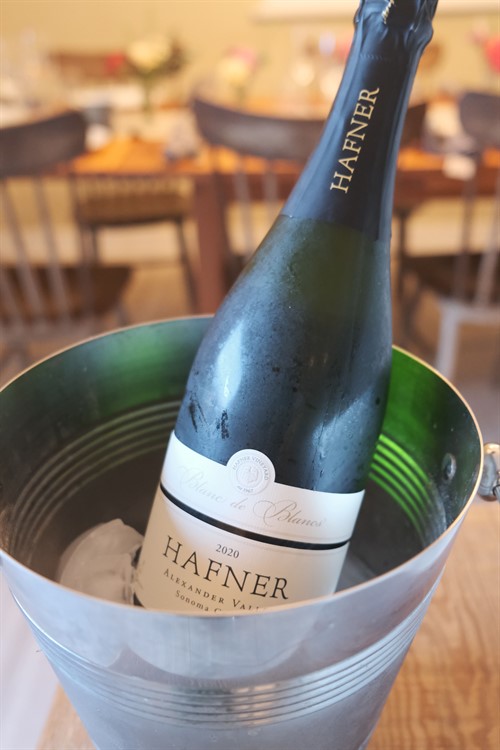 Being novices at producing sparkling wine, we turned to our longtime family friend, Chris Markell, who has had a long career making sparkling wine in California, Australia and France. His guidance has been extremely helpful. Producing sparkling wine is not for the faint of heart…it takes time, meticulous attention, and unending tastings (which is, of course, our favorite part.)
Being novices at producing sparkling wine, we turned to our longtime family friend, Chris Markell, who has had a long career making sparkling wine in California, Australia and France. His guidance has been extremely helpful. Producing sparkling wine is not for the faint of heart…it takes time, meticulous attention, and unending tastings (which is, of course, our favorite part.)
Each year, in late July and August, we walk through the vineyard several times a week tasting the berries to determine when we will begin the harvest. The grapes for sparkling wine are picked at a lower sugar level (19° Brix sugar) than still wines (22.5-23.5° Brix sugar) because the flavors are more delicate and more elegant with sweet pear and floral notes. The key to making sparkling wine is highlighting those fruit aromas.
Although it is more labor intensive and costly, we wanted to follow the techniques utilized in Champagne, France (“Méthode Champenoise”) to produce the finest sparkling wine possible.
Typically, we begin the sparkling wine harvest in early August. (For our still Chardonnay, we pick around Labor Day.) We handpick only at night in small yellow boxes (450 of them!) that have holes in them so that any juice that may come from the berries is drained away. This eliminates any phenolic pickup that comes from the skins and seeds.
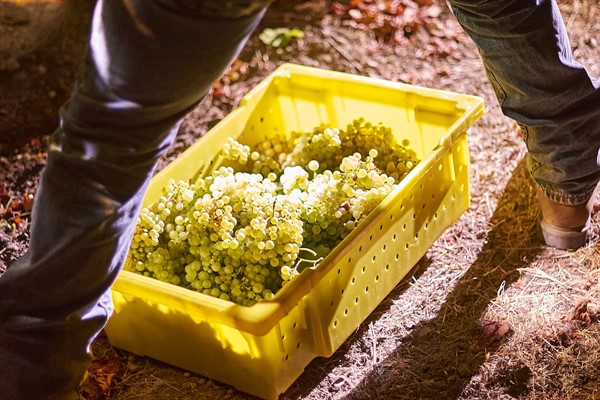
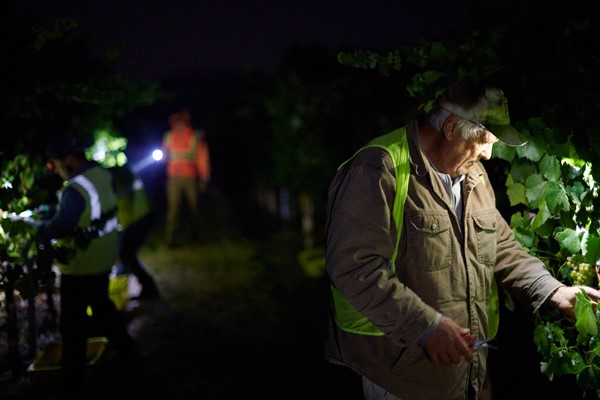
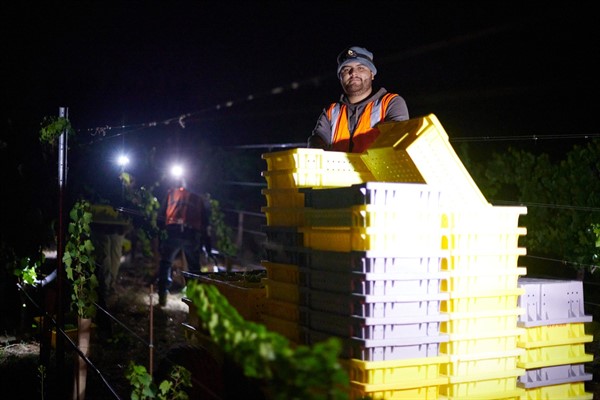
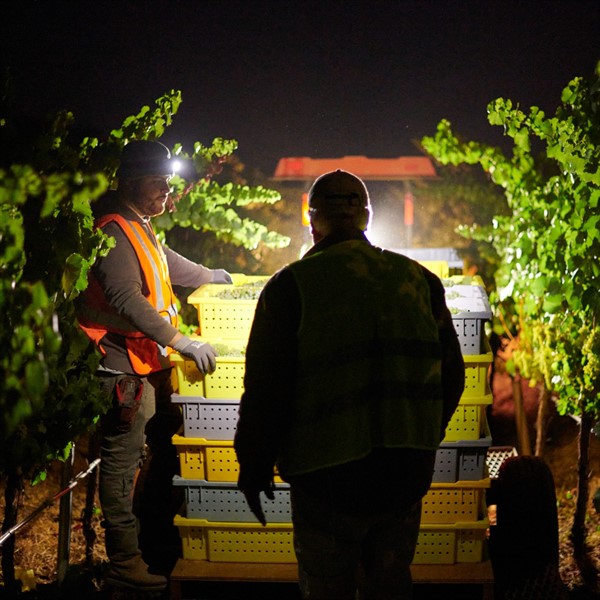
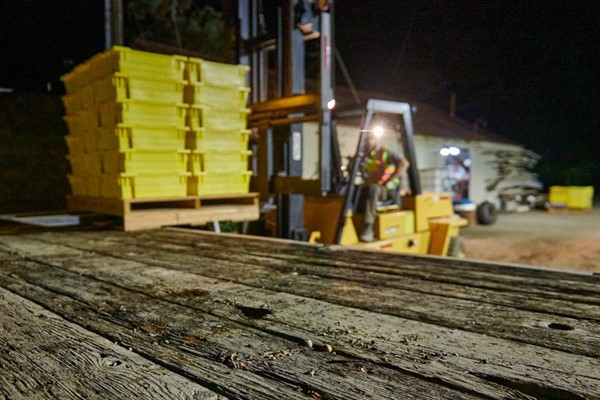 The full boxes are loaded onto the truck, destined for the winery.
The full boxes are loaded onto the truck, destined for the winery.
When the grapes arrive at the winery, we put the whole clusters directly into the press.
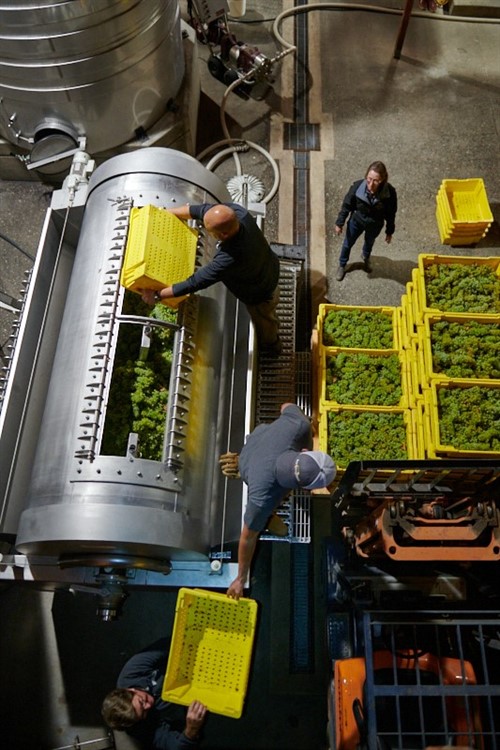
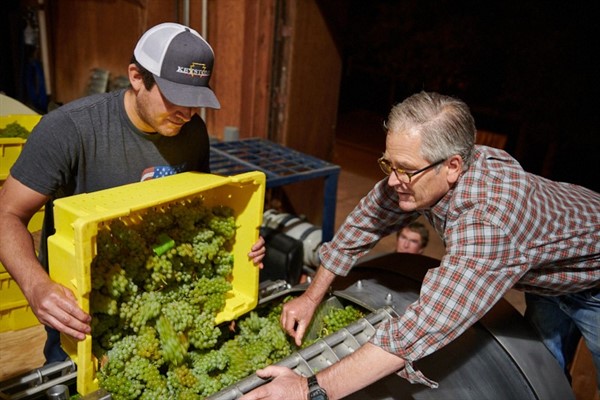 For still wines, the total press time is an hour and a half. For sparkling wines, the press runs twice as long, and we taste the juice at the end of each cycle to make sure it is fruit focused. We want to release as much juice as possible without compromising the delicate flavors. For still wines, we are able to extract ~165 gallons per ton; for sparkling wines, we get much less: ~120 gallons per ton.
For still wines, the total press time is an hour and a half. For sparkling wines, the press runs twice as long, and we taste the juice at the end of each cycle to make sure it is fruit focused. We want to release as much juice as possible without compromising the delicate flavors. For still wines, we are able to extract ~165 gallons per ton; for sparkling wines, we get much less: ~120 gallons per ton.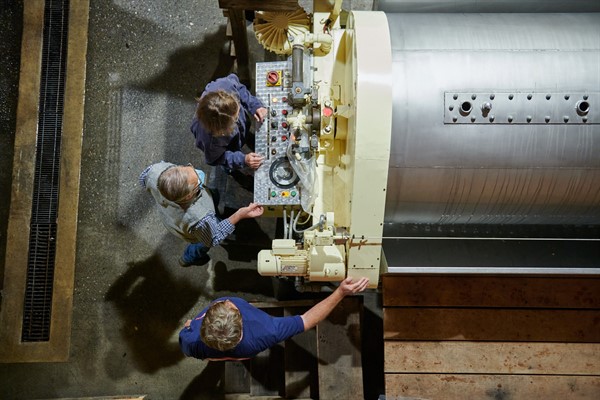 Chris, Sarah and I closely monitor the press.
Chris, Sarah and I closely monitor the press.
The juice is settled overnight to let any grape matter (lees) fall to the bottom of the tank. The next morning, we pump the clear juice off the sediment and begin primary fermentation with yeast specific to sparkling wine. The juice is fermented cool around 50° F and is monitored daily to make sure it is fermenting at the right rate. We also ferment a small amount in one-year-old barrels that we may use in our final blend. Barrel fermented wine has a richness and texture that gives wine complexity.
In January, we taste the tank fermented wine and the barrel fermented wine. We discuss each sample to determine which is the best for our blend. The goal is to add complexity and richness from the barrel fermented wine while retaining the delicate fruit aromas and flavors. For our 2020 vintage, we added three barrels to our tank fermented wine to create our “cuvée” (base wine) (about 8%).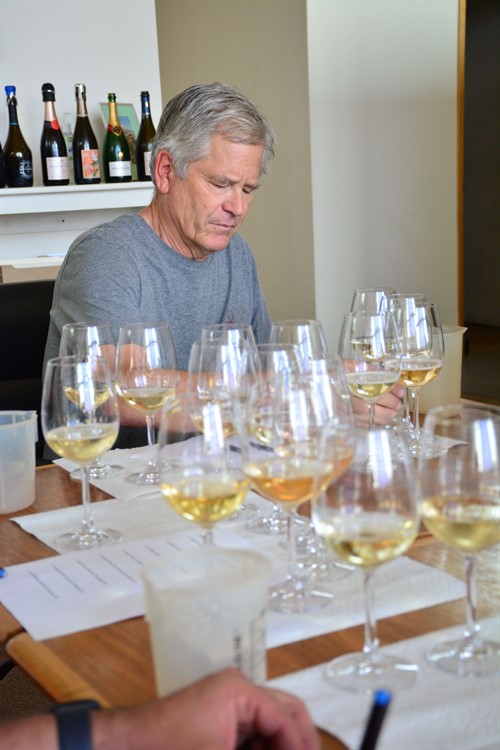 Once we have decided on the blend, we prepare the “liqueur de tirage” (yeast, sugar and wine) and add it to the cuvée during bottling. This initiates the second fermentation (which takes place in the bottle) where a still wine becomes a sparkling one. It sounds simple, but you need to ensure that every bottle has the same amount of liqueur, so the secondary fermentation is uniform in all bottles which gives the sparkling wine its carbonation.
Once we have decided on the blend, we prepare the “liqueur de tirage” (yeast, sugar and wine) and add it to the cuvée during bottling. This initiates the second fermentation (which takes place in the bottle) where a still wine becomes a sparkling one. It sounds simple, but you need to ensure that every bottle has the same amount of liqueur, so the secondary fermentation is uniform in all bottles which gives the sparkling wine its carbonation.
We are lucky to have our own bottling line, so we can closely monitor every detail. Once the liqueur is added and the tank well mixed, the first person on the bottling line puts the sterile bottles on the conveyer where they are filled, then leveled to the same height. Uniformity is key. 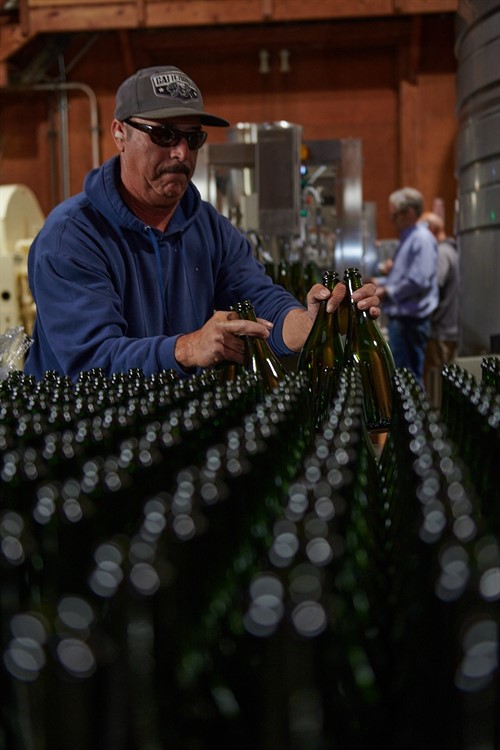 The next stage is where we insert the bidule (a ½” plastic cylinder where the yeast settles after fermentation) into the bottle.
The next stage is where we insert the bidule (a ½” plastic cylinder where the yeast settles after fermentation) into the bottle. 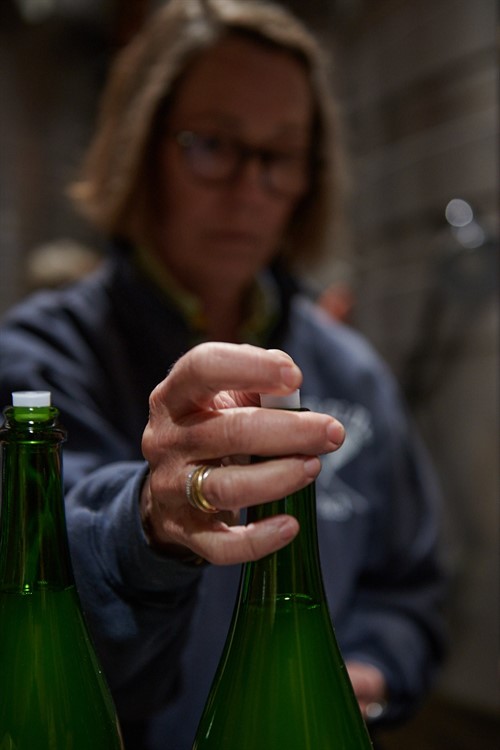 Next the bottle is sealed with a crown cap (like on a beer bottle). Two separate stations are needed to keep up with the bottling line.
Next the bottle is sealed with a crown cap (like on a beer bottle). Two separate stations are needed to keep up with the bottling line. 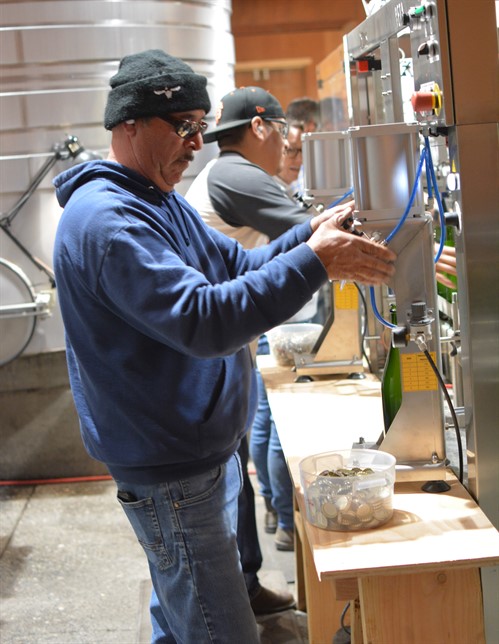 The last job is placing the bottles on their side in wire cages where they will age and undergo the second fermentation.
The last job is placing the bottles on their side in wire cages where they will age and undergo the second fermentation.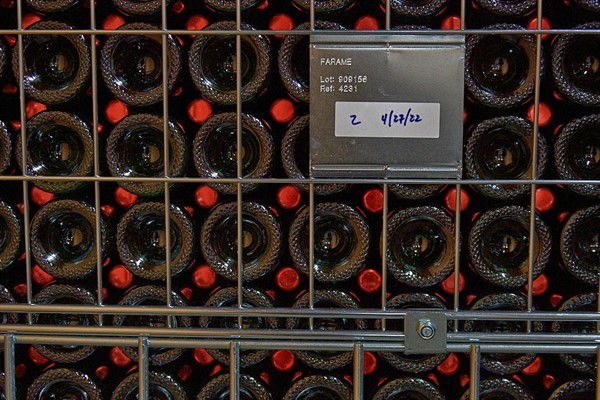 After a few months, we check the pressure inside the bottle and test the quality of the bubbles. The wine then ages for two years. The longer it ages, the more yeasty flavors it develops. Our goal is to add a hint of yeasty complexity to the delicate fruit aromas.
After a few months, we check the pressure inside the bottle and test the quality of the bubbles. The wine then ages for two years. The longer it ages, the more yeasty flavors it develops. Our goal is to add a hint of yeasty complexity to the delicate fruit aromas.
We work with a neighboring winery in Healdsburg, Rack and Riddle, who specializes in sparkling wine, to riddle and disgorge our sparkling wine. For the centuries, riddling was done by hand, but now it is done by machine. This process moves the yeast sediment (leftover from the second fermentation) down into the neck of the bottle into the bidule to later be removed during disgorging, which is the final step. You can learn more about the riddling process here.
During disgorging, the bottles are placed upside down into an ice bath where the necks are frozen. The crown cap is popped off and the plug of ice (with the bidule holding all of the sediment) blows off. The dosage that we created (a small amount of sugar and our wine) is added to the bottle and then each bottle is topped to the correct level with some of our sparkling wine. The bottles are corked and the “muselet” (wire hood and metal cap) is applied, securing the cork onto the bottle. Then the labels are applied.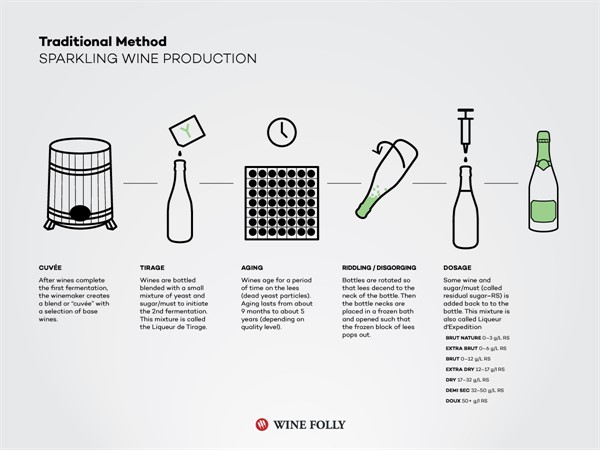 Source: Wine Folly
Source: Wine Folly
Making sparkling wine is challenging but great fun. And after 40 years of making still wines, it is exciting to learn new techniques and processes. Like with all winemaking, the small details impact the quality of the product, but it is the delicate nature of sparkling wine that requires a special attentiveness which we enjoy.
We are excited to announce that the 2020 Hafner Vineyard Blanc de Blancs will be released in November. Only 3,600 bottles were produced. To ensure that as many people as possible have the opportunity to try it, there is a twelve-bottle limit per patron. You can order it here. We hope you enjoy it as much as we do. And as we say at our home “Cheers”, “Cin, cin” or “Salud”!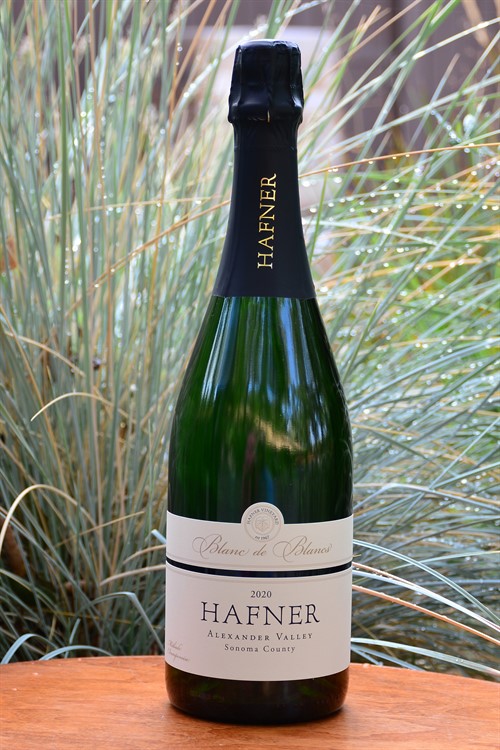 A big “Thank You!” to our in-house photographer, Sandy, and friend/photographer, Chris Bingham (@christopher.d.bingham), for capturing the process from early morning picking to finally bottled and labelled.
A big “Thank You!” to our in-house photographer, Sandy, and friend/photographer, Chris Bingham (@christopher.d.bingham), for capturing the process from early morning picking to finally bottled and labelled.



